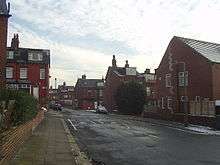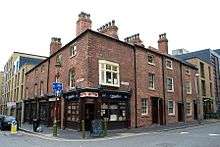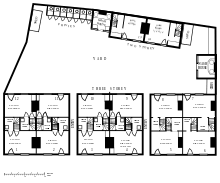Back-to-back house

Back-to-back houses are a form of terraced house in the United Kingdom. Many thousands of these houses were built during the Industrial Revolution for the rapidly increasing population of Britain's expanding factory towns. This sort of housing was deemed unsatisfactory, and the passage of the Public Health Act 1875 meant that no more were built; instead byelaw terraced houses took their place. One remaining court, the Birmingham Back to Backs, is now operated as a museum by the National Trust.
Description
Usually of low quality and high density, they were built for working class people. These houses were usually small, e.g. a two-up two-down (two rooms on each of two floors) or three floors of one room each. Two houses share a rear wall, or the rear wall of a house directly abuts a factory or other building. Because three of the four walls of the house were shared with other buildings and therefore contained no doors or windows, back-to-back houses were notoriously ill-lit and poorly ventilated; sanitation was of a low standard.
History


Houses of this type had become common in inner city areas of Victorian England, especially in Birmingham, Bradford, Leeds, Liverpool, Manchester, Salford, and Nottingham. In Leeds, this style of terrace continued to be built right up to 1937 when it was decided that houses should be of a higher quality.[1]
The advent of council housing after the First World War resulted in councils organising programmes of slum clearances which were all part of post-war redevelopment programmes (see Statutory slum clearance plans). These procedures saw the beginning of mass demolition of back-to-back houses in the 1920s. The process started again in the 1950s and continued through the 1960s,[1] and the 1970s, leaving most towns and cities with few or no back-to-back houses by the 1980s. However, in cities such as Leeds and Bradford[2] significant numbers remain and are still being used as housing.
Terminology


It has become common for the term "back-to-back" to be applied erroneously to "through" terraced houses, the backs of which face each other but are separated by an alleyway, and are thus not contiguous like a true back-to-back. Back-to-back houses can also be known as blind-backs particularly when built up against factory walls, or occasionally as a terrace of houses standing on its own. Other forms of back-to-back housing include tenements, courts, tunnel-backs and cluster houses.
See also
References
- 1 2 Hey, David, ed. (1996) The Oxford Companion to Local and Family History. Oxford University Press; p. 32
- ↑ "Back-to-back houses in Bradford". www.bradfordhistorical.org.uk. Retrieved 2017-03-11.
Further reading
- Beresford, M. W. (1984) "The back-to-back house in Leeds, 1787-1939", in: Beresford, M. W. Time and Place: collected essays; ch. 25. London: Hambledon Press ISBN 0907628397
External links
- Preserved Birmingham back-to-back houses
- Article on Bradford back-to-back houses
- Back-to-back housing in Reading